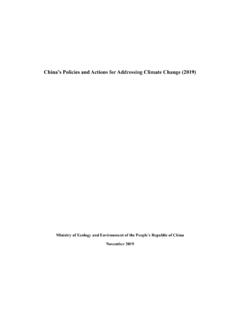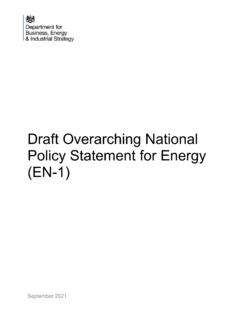Transcription of Using Artificial Intelligence for Smart Water Management ...
1 Using Artificial Intelligence for Smart Water Management Systems ADB BRIEFS. NO. 143. JUNE. 2020. KEY POINTS. Using Artificial Intelligence for Smart Water Management Systems Unaccounted-for- Water (UFW) is a key benchmarking parameter indicative of the operational and financial performance of a Water utility. Maximizing the Hubert Jenny Yihong Wang use of information and Former Principal Infrastructure Senior Investment Officer communications technology (ICT) for UFW improves the Finance Specialist East Asia Department quality of service delivery to East Asia Department Asian Development Bank customers. Asian Development Bank Despite an increased application of numerical tools Eduardo Garcia Alonso Roberto Minguez by Water utilities (Hydraulic Consultant Consultant Modeling ), the digital transformation of the Water sector is lagging behind other sectors, such as energy.
2 Cost- effective sensors combined with Internet of Things brings a paradigm shift for Smart INTRODUCTION. Water Management (Hydraulic Modeling ), supported by Data-driven intelligent applications have become disruptors to daily living. Innovative Artificial Intelligence and big Water utilities can benefit from this digital technology revolution to improve their data analytics. performance. By harnessing the power of Artificial Intelligence algorithms and big data analytics, Water utilities can maximize information and data available to make Key areas for policy action better decisions while enhancing service delivery and reducing costs. This brief include (i) enabling ethics introduces the principles of Artificial Intelligence for Water utilities embarking on this in Smart Water utilities digital transformation to improve their Water distribution operation in general, and to through regulation and public address unaccounted-for- Water problems in particular.
3 The brief describes some of participation to secure buy-in the most extended applications of big data analytics and Artificial Intelligence -related from consumers, and to algorithms in Water supply, discusses how Water utilities can pilot Artificial Intelligence protect their personal data; toward the prognosis of unaccounted-for- Water , and presents recommendations for (ii) issuing guidelines for a implementation and preliminary cost estimates. Smart Water road map to move Water utilities toward a digital transformation; ROLE OF Artificial Intelligence IN Water SUPPLY. and (iii) piloting Hydraulic Modeling , first targeting Artificial Intelligence (AI) comprises a branch of computer science dealing with the the prognosis for UFW. simulation of intelligent behavior in computers. 1 In the context of delivering efficient Water supply, AI or machine learning is mainly applied to decision-making tasks: how Water utilities can maximize information and data available to make better decisions while enhancing service delivery; optimizing capital investment (CAPEX); and reducing 1.
4 Merriam-Webster English Dictionary. 2020. Artificial Intelligence . ISBN 978-92-9262-268-8 (print) com/dictionary/ Artificial %20intelligence . ISBN 978-92-9262-269-5 (electronic). ISSN 2071-7202 (print). ISSN 2218-2675 (electronic). Publication Stock No. BRF200191-2. DOI: ADB BRIEFS NO. 143. operating costs (OPEX), including social and environmental replace humans in interpreting the data ( Water leak noises). With externalities. Water utilities are following the lead of other sectors, the advances in numerical modeling of the hydraulics of Water especially energy, sometimes without fully understanding the distribution networks, it is now possible to detect potential leaking underlying assumptions and implications in applying information pipe sectors through numerical methods, as long as the hydraulic and communications technology (ICT) into their operations.
5 Models are fed with a sufficient amount of calibrated field data such as pressure, flow, and node consumptions. The use of AI, in general, and in Water supply, in particular, has several policy implications to improve the performance of All the hydraulic variables in a Water distribution network show Water utilities and the quality of the service delivery: Ethics and some type of correlation, induced by underlying hydraulic laws governance deal with the protection of personal and financial (mass and momentum conservation, as explained in the Bernoulli data from consumers, and technical and financial data from Water principle), which represent the foundation of any Water distribution utilities. Regulation deals with benchmarking, since unaccounted- system. The numerical algorithms developed for Water leak for- Water (UFW) is one of the key operational parameters to detection aim to detect certain spatial and temporal patterns and determine the efficiency of a Water utility in reducing both physical anomalies in the values of the flow and pressure parameters at losses ( , Water leaks and pipe bursts) and commercial losses different points in the Water distribution network.
6 This is to extract (such as illegal connection and metering errors).2 Technical information about physical and commercial losses. Numerical policies deal with line ministries and Water associations to update methods require calibration with field data; when a Supervisory the national and Water Code of Practice, and to guide Water Control and Data Acquisition (SCADA) monitors the Water utilities in their digital transformation. Financial policies address distribution system, numerical methods become a cost-effective short-term CAPEX requirements to finance Smart Water utilities investment (see Figure). with new financing instruments. Literature review on UFW and nonrevenue Water (NRW) shows The digital transformation of Water supply supports the Sustainable many attempts to take advantage of both data and big data from Development Goals (SDG), especially SDG 6: Ensure availability cost-effective sensors, calibrated hydraulic modeling of the Water and sustainable Management of Water and sanitation for all; and distribution network, and advanced numerical techniques.
7 There SDG 13: climate Action, by taking urgent actions to promote are two main approaches in the numerical routines used for climate -related investments to combat climate change impacts. network analysis, each one with distinct methods and underlying In addition, application of AI numerical tools to the Water sector hypotheses: largely contributes to addressing key global Water sector challenges, such as (i) Physically based methods draw on the combination of statistical tools, such as state estimation techniques and (i) Water assets that are aging and deteriorating, and CAPEX pressure sensitivity analysis, with hydraulic and OPEX limitations to control Water tariff increases; The physical methods can take full advantage of the (ii) Water as a growth-limiting factor in the Water food energy underlying universal physical laws (conservation of mass nexus, both in terms of quality and scarcity, compounded by and momentum) that govern Water distribution networks.
8 climate change impacts and increased urbanization; and The seamless combination of data and numerical models (iii) integrated Water resources Management , which needs to eventually enables a digital twin or digital mirror of be promoted at the regional and city levels with low-impact the physical Water distribution network to test and check development for sponge scenarios in real time. This approach is common to other sectors, for instance, in the operation of power distribution For UFW, physical Water leak detection techniques are based on combining special equipment (acoustic sensors, gas tracers, etc.) with human skills. A current trend is to incorporate AI in From the point of view of operations, physically based some of this hardware (for instance, acoustic correlators) to methods are the starting point for Water utilities into their 2.
9 The International Benchmarking Network for Water and Sanitation Utilities (funded by the World Bank Group and the International Water Association with the support of other development partners and stakeholders) promotes good benchmarking practices among Water and sanitation services. See International Benchmarking Network. 3. Low-impact development applied to sponge cities is a land planning and engineering design approach to manage stormwater as part of climate adaptation proofing of urban infrastructure. It emphasizes conservation and use of on-site-natural features to protect Water quality. 4. D. Jung and J. H. Kim. 2018. State Estimation Network Design for Water Distribution Systems. Journal of Water Resources Planning and Management . 144 (1);. S. G. Vrachimis, D. G. Eliades, and M. M. Polycarpou. 2018.
10 Real-time Hydraulic Interval State Estimation for Water Transport Networks: A Case Study. Drinking Water Engineering and Science. 11 (1). pp. 19 24; S. D az, J. Gonz lez, and R. M nguez. 2016. Uncertainty Evaluation for Constrained State Estimation in Water Distribution Systems. Journal of Water Resources Planning and Management . 142 (12); H. R. Asgari and M. F. Maghrebi. 2016. Application of Nodal Pressure Measurements in Leak Detection. Flow Measurement and Instrumentation. 50. pp. 128 134; and R. P rez et al. 2011. Methodology for Leakage Isolation Using Pressure Sensitivity Analysis in Water Distribution Networks. Control Engineering Practice. 19 (10). 5. E. Caro, R. M nguez, and A. J. Conejo. 2013. Robust WLS Estimator Using Reweighting Techniques for Electric Energy Systems. Electric Power Systems Research.












